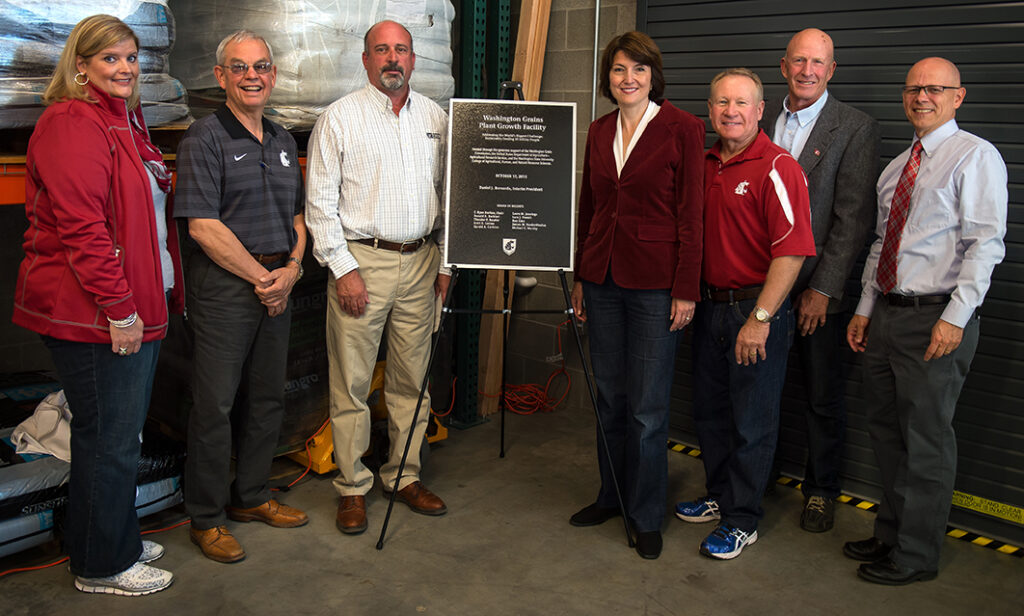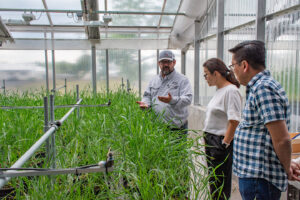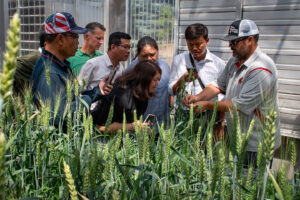Normal 0 false false false EN-US X-NONE X-NONE /* Style Definitions */ table.MsoNormalTable {mso-style-name:"Table Normal"; mso-tstyle-rowband-size:0; mso-tstyle-colband-size:0; mso-style-noshow:yes; mso-style-priority:99; mso-style-parent:""; mso-padding-alt:0in 5.4pt 0in 5.4pt; mso-para-margin:0in; mso-pagination:widow-orphan; font-size:12.0pt; font-family:"Calibri",sans-serif; mso-ascii-font-family:Calibri; mso-ascii-theme-font:minor-latin; mso-hansi-font-family:Calibri; mso-hansi-theme-font:minor-latin; mso-bidi-font-family:"Times New Roman"; mso-bidi-theme-font:minor-bidi;} Greenhouse expansion was created through unique partnership between Washington Grain Commission, WSU, and USDA
By Seth Truscott
A decade ago, wheat breeders at Washington State University (WSU) were feeling the squeeze. Their 1990s-era greenhouse facility was too small to serve expanding spring and winter wheat breeding programs.
Realizing the need, WSU leaders, members of the Washington Grain Commission (WGC), and counterparts with the U.S. Department of Agriculture (USDA) came together to build a modern greenhouse expansion. From initial discussions in 2012, the resulting Plant Growth Facility opened in 2015. Now fully paid off, the facility is contributing to faster, more efficient breeding and competitive new wheat varieties.
“The three-way partnership that built the Plant Growth Facility was unique,” said Wendy Powers, the Cashup Davis Family Endowed Dean of WSU’s College of Agricultural, Human, and Natural Resource Sciences. “It showed that growers, researchers, and agencies can do more when they work together, and has become a model for meeting our critical infrastructure needs.”
Normal 0 false false false EN-US X-NONE X-NONE /* Style Definitions */ table.MsoNormalTable {mso-style-name:"Table Normal"; mso-tstyle-rowband-size:0; mso-tstyle-colband-size:0; mso-style-noshow:yes; mso-style-priority:99; mso-style-parent:""; mso-padding-alt:0in 5.4pt 0in 5.4pt; mso-para-margin:0in; mso-pagination:widow-orphan; font-size:12.0pt; font-family:"Calibri",sans-serif; mso-ascii-font-family:Calibri; mso-ascii-theme-font:minor-latin; mso-hansi-font-family:Calibri; mso-hansi-theme-font:minor-latin; mso-bidi-font-family:"Times New Roman"; mso-bidi-theme-font:minor-bidi;} Proven partnership
The seeds of the partnership were planted in a 2012 conversation between WSU wheat breeders Arron Carter and Mike Pumphrey and Grain Commissioner Dana Herron.
“His questions were, ‘What challenges do you face? What do you need?’” said Carter, WSU’s O.A. Vogel Endowed Chair of Winter Wheat Breeding and Genetics. ‘More greenhouse space,’ came the answer.
“We’d made some major moves in the wheat breeding program,” recalled Dan Bernardo, provost emeritus and dean of CAHNRS from 2005-2013. “We had great breeders, excellent lab facilities, great staff—but the pinch point was plant growth facilities to grow out the selections.”
Working with the commission, Bernardo helped develop the private-public partnership to expand and update WSU’s growth facility. In spring 2012, the commission contributed $5 million for construction. The university pledged $5 million from royalties on future wheat variety releases.
“This project proved Washington growers’ commitment to research,” said Mary Palmer Sullivan, WGC vice president. “It also illustrates how farmers are proactive.”
The commission was instrumental in gaining $5 million in support from USDA, which was used to equip the building with state-of-the-art growing chambers, seed storage, a dedicated spray facility, and other furnishings.
“When we ask for help, we come in with solutions,” Palmer Sullivan said of the effort to secure additional funding. “This reiterates our ability to leverage opportunities and show we are real partners.”

Faster results, better varieties
Attached to the original 15,000 square-foot facility on Wilson Road, the expansion added 7,200 square feet of greenhouse areas that tripled growing space for new wheat lines, enabling WSU wheat breeders to shave two years off the four previously needed to increase stable seed for field observation and selection.
“It’s a compound effect,” said Pumphrey, WSU’s O.A. Vogel Chair of Spring Wheat Breeding and Genetics. “With more space, we could plant multiple generations and fix and screen traits in the greenhouse before we send them to the field. It’s increased, by about 40 percent, our ability to generate materials that are stable and ready to be evaluated.”

The spray chamber was another major timesaver, cutting a year off the time involved in confirming herbicide resistance.
Greenhouse space, seed storage, the dedicated spray chamber, and the ability to perform double-haploid wheat breeding more quickly are the four areas where the new building has made the biggest difference, Pumphrey said.
“We can point directly to a number of varieties that were started at the same time as the growth facility, and we’ve already released them,” he said.
Since expansion, WSU breeders have released nearly 10 competitive varieties, including Piranha CL+, the top-planted soft white winter wheat in Washington; top-10 winter wheats Stingray CL+ and Sockeye CL+; top-six hard winter red Scorpio; Hedge CL+, the top planted soft white spring club wheat; hard red spring wheat Net CL+; Butch spring wheat; and Nova AX and Devote winter wheats, among others. Promising new variety WA 8351, expected to become the leading soft white spring wheat, will release next spring.
“For farmers, the impact is on the time to release,” Pumphrey said. “For us wheat breeders, it’s the reduced time to make the next cross. That’s what determines our potential. By reducing cycle time, we’re able to get desirable traits stacked up more and more with every generation.”

When buyers from overseas visit Washington, commissioners make a point of visiting the Plant Growth Facility and showing the work happening there.
“We’re proud of the building and the partnership: it’s where everything starts,” Palmer Sullivan said. “It’s something I hope will carry on into perpetuity.”
With the building paid off, WSU is planning to put future royalties to work to improve wheat breeding and research. Royalties will be used to modernize infrastructure at WSU’s Spillman, Wilke, and Lind research farms and develop a new fellowship program training the next generation of wheat researchers and professionals. Every investment will directly impact wheat growers in Washington.
The success of the Plant Growth Facility partnership set a precedent that’s most recently exemplified by the new USDA-ARS Plant Sciences Building being constructed at Pullman.
“This novel approach is our future,” Powers said. “Support from our partners is an investment in research that continues to pay forward for Washington grains.”

Seth Truscott
Seth Truscott is a public relations and communications coordinator for the Washington State University College of Agriculture, Human, and Natural Resource Sciences, and a contributing author for Wheat Life Magazine.
